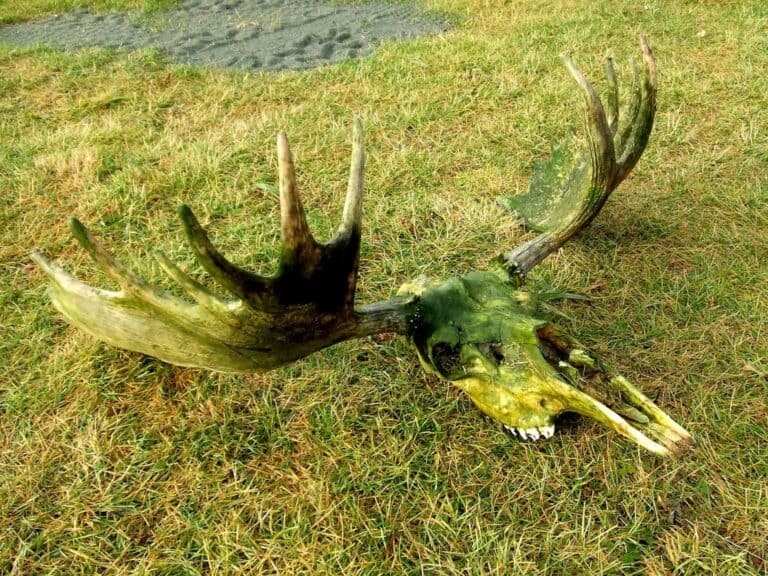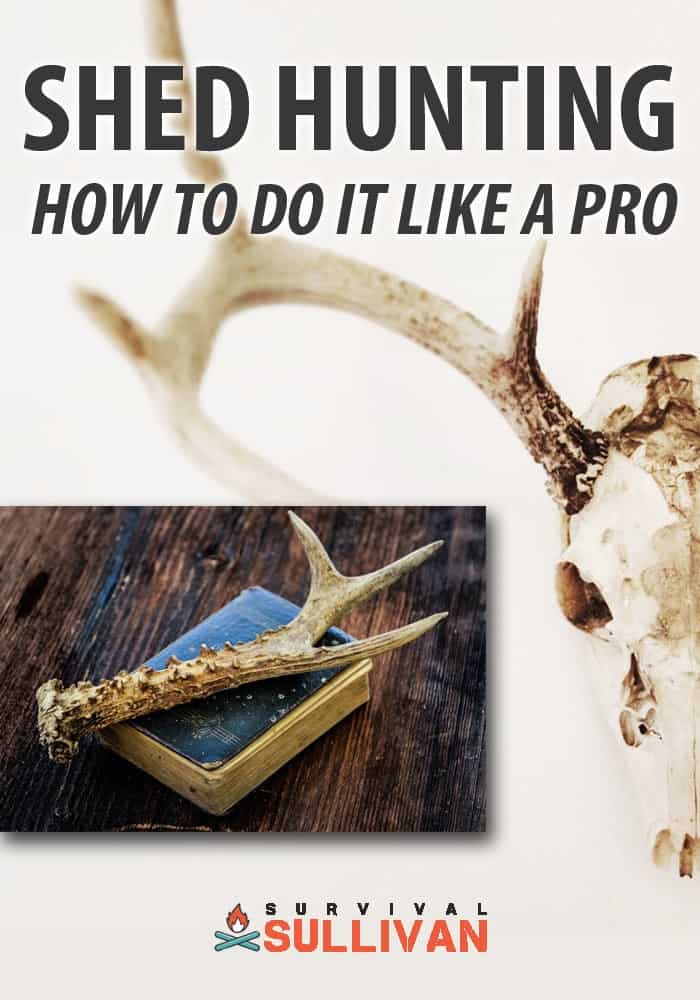When you hear someone mention “Sheds,” they are likely referring to the dropped, or shed, antlers of deer and other antlered animals that are lost each year following mating season.

The hard bone-like material of the antlers keeps them from breaking down in the wild. Once the spring thaw arrives and the snow melts off, the antlers are scattered amongst the forest.
While the antlers are hardened against most of Mother Nature, there are several species of animals that will gnaw and eat in the sheds to get to the minerals they hold. Animals such as squirrels, chipmunks, and rodents are known for this behavior.
Shed hunting has long been a spring past-time among hunters and outdoorsmen. It provides an early spring activity to those who are ready to get back out into the woods and fields.
The activity has grown in popularity over the past years, and is now more prevalent than ever. Commercial guides have even taken advantage of the popularity boom, with some now offering shed hunts on prime property and all amenities. Some of these hunts sell as high as $3000 for a week-long trip.
There are many species in the US that shed their antlers each year:
- Whitetail Deer
- Blacktail Deer
- Mule Deer
- Elk
- Moose
Table of Contents
Why Hunt Sheds?
They are many reasons people hunt sheds. For some its about tradition. Taking young kids into the spring woods to search for the “white gold.”
As these kids have gotten older, they are now continuing the tradition and passing it along to their kids. The draw toward social grouping today has led to the creation of shed hunting groups that have scheduled outings.
Crafting Material
Antler can be used in a variety of crafting projects. One of the most popular applications is knife and tool handles. The use of antler as a handle material for knives and tools can be dated back to Native American tribes hundreds of years ago. The material feels comfortable in hand, is textured for a secure hold, and is strong enough to last.
Another popular product is furniture and decorations. Everything from ornate and complex chandeliers to a full living room suite can be made from antlers.
Exercise
Everyone needs a little exercise after the long winter. Getting out in early spring and searching for sheds is a great way to get you moving and burning off those extra winter pounds. Since you have to go where the deer go, you can usually expect a good cardio workout as well.
Cabin Fever
Everyone gets “cabin fever” after a while stuck indoors. After a few good rounds of snow, my wife is practically throwing me out of the house. Outdoorsmen are best suited for the woods; we don’t do well all cooped up. Getting out and searching the woods is good medicine if the fever gets you down.
Antler can be used in a variety of crafting projects. One of the most popular applications is knife and tool handles.
The use of antler as a handle material for knives and tools can be dated back to Native American tribes hundreds of years ago. The material feels comfortable in hand, is textured for a secure hold, and is strong enough to last.
Another popular product is furniture and decorations. Everything from ornate and complex chandeliers to a full living room suite can be made from antlers.
Benefits to Hunters
As a deer hunter, the information that you glean from shed hunting is invaluable. The antlers are shed as the animals move around the woods.
Sometimes they drop on their own while the animal is walking due to the force of gravity, other time they will get caught on a branch or other obstacle and come loose due to the resistance. Very similar to how a child loses a baby tooth.
What this means is that by looking at where the sheds are found on a property, you can deduce information about the deer herd’s movement. You may be able to identify travel corridors, bedding areas, feeding areas, and more.
Another piece of information is the health of the herd. It is well established that antler growth is directly related to nutrition and health. By examining the antlers for shape, size, and thickness, you can gauge how well the deer are getting the nutrients they need.
Also while you are shed hunting, you will come across deer that did not survive the season. These finds can tell you about the loss from the herd and about what killed them. Antlers from dead deer and intact skulls do make nice trophies, but you need to check on the legality of collecting them within your state and area.
These two factors together can also show what deer survived the hunting season and winter. The number of sheds can also help you judge the size of your herd.
Another benefit to hunters is that while you are shed hunting, you are learning about the particulars of your property.
After the snow melts, you will be able to see all of the deer sign that was leftover from the end of fall and the mating seasons. Discovering rubs, trails, bedding sites, and similar evidence can team you about features of your property such as natural funnels or holding areas.
If you are a trophy hunter, you can also learn which big bucks survived, and work on identifying your target deer for the fall.
We know that deer often haunt the same areas during the mating season. We also know that antlers grow back in the same pattern as the year before, just with additional growth. With that information, we can look for a specific rack in trail cam footage and pick out specific deer.
What do you do with the Antlers?
Decorations
There are a variety of uses for the shed antlers that are found. One of the most common is for decoration. Very prominent across the south, decoration with antlers can be found in many homes and businesses.
Sometimes they are used just as they are, and others can they can be turned into everything from bookends to chandeliers.
Selling for Profit
With the rise in popularity of shed antlers, there is a high demand for items made from the antlers. This has driven up the price for selling the antlers to craftsmen and other people who use them in their work.
Some shed hunters find hundreds of sheds each year and sell them for a profit. When selling antlers, it is often the larger and more massive antlers that sell the best, which causes shed hunters to try and get to them earlier to make sure they are not picked up by others.
This behavior is becoming a concern for wildlife, as overeager hunters will push the already weakened from the winter deer out of their wintering areas too early. This forced the deer to expend energy some may not have while searching for food and a new area to hunker down.
All of this attention and overzealousness has prompted many states to implement shed hunting seasons. One example is Colorado where their Parks and Wildlife Department has enacted a regulation that prohibits antler and horn collection from Jan. 1 to April 30.
Dog Chews
Another area that antler has become very popular is for use as a dog chew toy. Over the last ten years or so veterinarians have discovered that real bones can be dangerous to dogs.
This is due to the potential of splinters of the bone getting caught or rupturing the bowels, which is either a complicated and expensive surgery or death in most cases. This has created a market for alternative chews for dogs.
Some vets still do not recommend antler as a safe alternative, but most of the hesitation with antler is due to dogs breaking teeth rather than the material splintering.
Personally, my dog loves her antler. I don’t cut them down, but instead just give her the whole thing, and she carries it around like a trophy. She has been chewing on an antler from a big ten point for almost a year now.

When and where to find Sheds
When shed hunting you are going to be looking for areas that the deer might have chosen to over-winter. Deer need access to fresh water, food, and shelter. If you know of a field where deer feed, look for thickets in the woods surrounding that field.
The same concept goes for bedding areas. If you know that deer are bedding in a particular area, look out towards possible sources of food and water, and then search for their trails.
A well-traveled trail between a bedding area and a feeding area will most likely hold several pairs of sheds. One of my favorite locations to search is along creeks. Deer will travel to the creeks and streams to drink, and often get tangled with the low brush, which will cause the antlers to drop off.
Generally speaking, the thicker the cover in an area, the better chance deer have been holding there. They enjoy the extra security of the dense and thick cover in the winter. Of course, the more deer have been using the area, the better the chances of finding sheds there.
Another good area to look at is fencelines. Deer naturally jump to clear fences along their trails, and the force of jumping can cause the antlers to break free.
When
When to hunt sheds can be a little bit varied depending on the weather and where you are located. Generally, most deer will drop their antlers by March. This will hold true for most of the lower 48. Particularly cold and snowy winters will cause the deer to hold onto their antlers longer, as will very dry winters.
The popular belief is that larger deer will drop their antlers earlier in the year. For this reason, you will find some hunters out in the woods mid to late February. They are hoping to find a massive pair of sheds before anyone else does.
Additional Tips and Tricks
Hunting with dogs
One popular option for hunting sheds is to used trained “shed dogs.” These hunting dogs are specifically trained to run ahead of their handler and search for shed antlers hidden throughout the forests or fields, and then bring them back to the handler.
Shed dogs have grown in popularity along with shed hunting. There are now nationally recognized dog trainers who offer fully trained shed dogs for purchase. Most dogs can be trained to find antlers, but generally breeds such as Labrador retrievers, german shorthair retrievers, beagles, pointers, American foxhounds, and bloodhounds.
Don’t Trespass
It may seem obvious that trespassing is bad, but for some reason, people think that it is ok if you are shed hunting since it’s not animal hunting. Well, that is simply not true. Crossing onto private property for any reason without permission is trespassing. Stay on your side of the fence.
On the other hand, asking permission to shed hunt is a pretty good way to gain access to private land. If you are respectful and follow the rules the landowner give you, you might be able to gain access for other types of hunting and fishing in the future.
Keep Walking
Shed hunting can be a bit of a hike. To find more sheds, you need to cover more ground. While some techniques, such as glassing with binoculars, will help, in the end, you are just going to have to walk.
Also, slow down. When you are looking for sheds, you should be looking straight down. This is not possible to do if you are walking to fast. Slow down and pay attention. Walking isn’t all that bad for those of us that are itching to get back in the woods after a long winter. You may just burn off some of those extra holiday pounds
Don’t look for antlers, and Don’t look to Hard
While this may sound contradictory to the mission at hand, it is true. A newbie will walk a trail and come out empty handed when a seasoned vet will come out with a hand full of sheds. The difference is in how they are looking.
First, try not to look for an antler. Often times they are either in thick cover or are partially buried under leaves or other debris. What you will be able to see, is an ivory colored tine, or the bulbous base sticking out.
These shapes are not natural to sticks and twigs so they will stand out if you are not looking too hard. If you are focusing on each square inch, you will look right over top of them. If you look at the area as a whole, the contrast will stand out.
Bring along some Binoculars
One way to help you find sheds is to use a pair of binoculars to scan large areas. Try to find a high vantage point, and glass along the forest floor or the field edge.
Remember to look for the small sections of antler. If you are lucky, you will spot a large shiny white patch in the middle of all that brown. Using binoculars shed hunting also helps you practice your glassing technique, which can be an essential hunting skill.
Ready to Do Some Hunting?
Regardless of why you are interested in shed hunting, what you plan to do with your sheds, or how you go about hunting them, the important thing is to get outside and try it.
Have fun while you are at it. This is a great time to be in the woods. Enjoy each antler, take a selfie and share it own your flavor of social media, jot down the location and date on the base of the antler, or whatever you like to do with them.
The renewable resource is replenished every spring, and short of some rodents gnawing on them, they don’t specifically benefit any other animals. Besides, with as much as shed hunting is catching on as of late, if you don’t go find them, someone else will.


Born and raised in Kentucky, Steve grew up deep in the mountains on a family farm. After college, Steve spent over 15 years working in public service and has experience in Fire, EMS, and Law Enforcement. He has also worked with training and deploying search & rescue and service dogs for utilization in a variety of services.
Steve is also a Scout Leader with the Boy Scouts of America, and works to teach preparedness to the next generation. Steve has worked with and taught firearms and self-defense in multiple venues, from tactical applications to long range shooting, and also has extensive training in first aid and wilderness first aid.
An active prepper, Steve has devoted hundreds of hours to mastering and teaching skills and techniques for use in survival, homesteading, and general preparedness.

Great article, Shed hunting is something I’ve wanted to try for years. Now that I’m retired it should be fun. Thanks for the information.
Joe W.
Great article